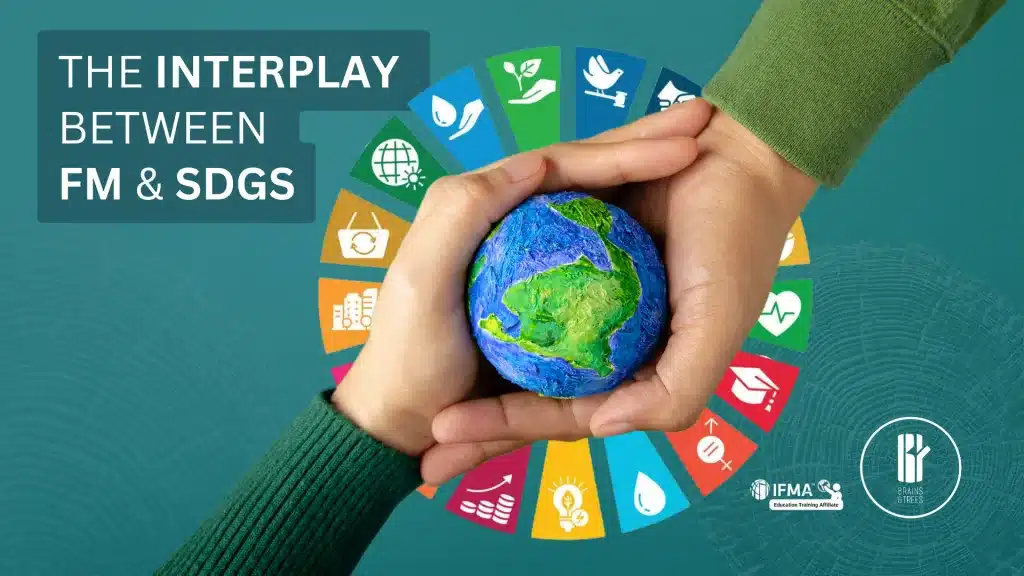Author: Jean-Pierre Segers (Brains & Trees; UHasselt;)
Introduction
The relationship between facility management (FM), sustainability, and the Sustainable Development Goals (SDGs) is symbiotic. Facility management plays a crucial role in shaping the built environment, ensuring it is safe, efficient, and conducive to the well-being of its occupants.
Facility Management and Sustainability
Sustainability is a core principle in modern facility management. It involves creating and maintaining built environments that are functional, comfortable, and environmentally responsible. Key sustainable FM practices include:
- Energy-efficient building designs
- Waste reduction initiatives
- Water conservation efforts
- Use of sustainable materials
These practices contribute significantly to broader sustainability objectives and align with global efforts to mitigate environmental challenges.

The Sustainable Development Goals (SDGs)
The 17 SDGs, established by the United Nations in the 2015 “2030 Agenda for Sustainable Development,” offer a blueprint for achieving a sustainable future where no one is left behind. Several SDGs are particularly relevant to facility management:
- Goal 7: Affordable and Clean Energy – FM can promote energy efficiency and renewable energy in buildings.
- Goal 11: Sustainable Cities and Communities – FM contributes to creating inclusive, safe, resilient, and sustainable urban spaces.
- Goal 12: Responsible Consumption and Production – FM practices help minimize waste and promote sustainable resource use.
- Goal 13: Climate Action – FM supports climate change mitigation through sustainable building practices and emissions reduction.
Tech-Driven Hybrid Workplace Models
The workplace is evolving, driven by technological innovations and the need for sustainable and adaptable practices. FM, HR, and IT are increasingly intertwined in supporting corporate goals related to ESG, employee engagement, health, and well-being.
The hybrid workplace emerged in response to the COVID-19 pandemic, reshaping how organizations operate. It blends on-site and remote work, focusing on:
- Real Estate Optimization
- Employee Experience
Hybrid working optimizes organizational value by prioritizing employees, the true engine of success. Flexible options such as shared offices, satellite locations near transportation hubs, and advanced videoconferencing enable seamless collaboration in distributed teams.
People-Centric Buildings
In line with SDG 3 (Good Health and Well-being), FM aims to deliver employee-centric buildings. These environments prioritize wellness and a connected workplace experience, addressing challenges like communication, knowledge sharing, and performance evaluation. Key approaches include:
- WELL Building Standards
- Digital innovations (AI, IoT, PropTech, smart workplace apps)
- Data-driven insights (space utilization, energy audits)
These efforts align with sustainability certifications like BREEAM and LEED, reducing lifecycle costs and enhancing business efficiency.
Emerging Business Models in FM
The facility management industry is adapting to sustainable goals with innovative business models, such as:
- FM as a Service
- Occupancy as a Service
- Space-as-a-Service
- Circular Workspace Solutions (“The Netflix of Furniture”)
These models foster shared value, strengthening competitive advantage while benefiting communities.
Skills and Competencies for the Future
The pandemic accelerated digital transformations, redefining required skills in FM. New technologies like digital twins, AR/VR, and AI necessitate upskilling and reskilling. Future-ready professionals must adopt:
- T-shaped skills (depth in one area, breadth in others)
- M-shaped skills (broad expertise across disciplines)
SDGs in the Built Environment
Facility management’s primary goal is to create high-performing, cost-effective, sustainable workplaces that meet people’s needs for health and well-being (SDG 3). Interlinkages exist with:
- SDG 7: Clean energy and efficiency
- SDG 8: Decent work and economic growth
- SDG 9: Resilient infrastructure
- SDG 11: Sustainable cities and buildings
Conclusion
Sustainable facility management practices are vital to achieving the SDGs. By embracing sustainability, FM professionals can create resilient, efficient built environments that meet the needs of current and future generations while minimizing environmental impact. Together, FM and sustainability provide a roadmap for a better, more sustainable future.

Brains & Trees is a training company for both aspiring and seasoned Facility Management professionals. Our aim is to close the growing skills gap in the industry and to fuel lifelong learning.
If you want to receive the detailed information shared in the Master Class contact us on info@brainsandtrees.com or www.brainsandtrees.com



